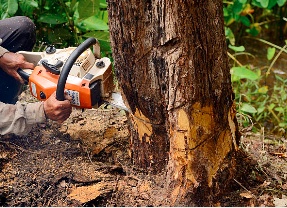Tree stump removal is a crucial aspect of landscaping and property maintenance that often gets overlooked. While felled trees may seem harmless, the remaining stump can pose various hazards and detract from the beauty of your outdoor space. In this article, we'll explore the reasons for removing tree stumps, different removal methods, considerations for hiring professionals versus DIY, environmental impacts, safety precautions, and aftercare tips.
Introduction to Tree Stump Removal
After a tree has been cut down or has fallen, the leftover stump remains rooted in the ground. While some may choose to leave stumps as natural elements in their landscape, they can present numerous challenges and safety risks. Tree stump removal involves eliminating the remaining portion of the tree trunk and its roots from the ground, restoring the area to a flat surface.
Reasons for Removing Tree Stumps
Safety Concerns
One of the primary reasons for removing tree stumps is safety. Stumps protruding from the ground pose tripping hazards, especially in high-traffic areas. They can cause injuries to people walking or playing in the vicinity, making removal essential for ensuring a safe environment, particularly in residential areas.
Aesthetics and Property Value
Beyond safety concerns, tree stumps detract from the visual appeal of your landscape. They can make mowing and landscaping more challenging and diminish the overall aesthetics of your property. Removing stumps enhances the beauty of your outdoor space and can increase property value by creating a more appealing environment.
Preventing Regrowth
Leaving a tree stump in the ground may lead to new growth from the remaining roots. This regrowth can result in unwanted saplings or suckers sprouting around the stump, requiring additional maintenance efforts to control. Removing the stump entirely prevents any potential regrowth, keeping your landscape tidy and manageable.
Methods of Tree Stump Removal
There are several methods available for removing tree stumps, each with its own advantages and considerations:
Grinding
Stump grinding is a popular and efficient method that involves using a stump grinder to shred the stump and roots into small wood chips. This process allows for complete removal below the ground surface, leaving the area ready for replanting or landscaping.
Chemical Removal
Chemical stump removal involves applying specialized chemicals to the stump to accelerate decomposition. While this method is less labor-intensive than grinding, it typically takes longer to fully eliminate the stump, and there may be environmental considerations regarding the use of chemicals.
Manual Removal
Manual stump removal involves digging around the stump and cutting through the roots with an axe, saw, or chainsaw. While this method is labor-intensive and time-consuming, it can be suitable for smaller stumps or situations where access for machinery is limited.
Hiring a Professional vs. DIY Stump Removal
Deciding whether to hire a professional stump removal service or tackle the task yourself depends on various factors:
Cost Considerations
Hiring a professional stump removal service can be more expensive upfront but may save time and effort in the long run. DIY removal methods may be more cost-effective but require the purchase or rental of specialized equipment.
Safety and Expertise
Removing tree stumps can be hazardous, especially when using heavy machinery or power tools. Professionals have the experience and expertise to safely and efficiently remove stumps without causing damage to surrounding property or utilities.
Environmental Considerations
When removing tree stumps, it's essential to consider the environmental impact:
Impact on Surrounding Vegetation
Stump removal can disturb the soil and surrounding vegetation. Careful planning and consideration are necessary to minimize disruption to the ecosystem and preserve the health of nearby plants and trees.
Soil Health
The decomposition of tree stumps can enrich the soil with organic matter over time. However, chemical stump removal methods may affect soil pH and nutrient levels, potentially impacting future plant growth.
Steps to DIY Tree Stump Removal
If you choose to remove a tree stump yourself, follow these steps:
- Assessing the Stump: Determine the size, location, and condition of the stump to select the appropriate removal method.
- Choosing the Right Method: Consider factors such as stump size, accessibility, and available equipment when deciding between grinding, chemical, or manual removal.
- Tools and Equipment Needed: Gather the necessary tools and safety equipment, such as a chainsaw, shovel, protective gear, and stump grinder (if applicable).
- Step-by-Step Removal Process: Follow the instructions for your chosen removal method, taking precautions to ensure safety and minimize damage to surrounding areas.
Safety Precautions
When removing tree stumps, prioritize safety by:
- Wearing appropriate protective gear, including gloves, safety goggles, and sturdy footwear.
- Using tools and equipment correctly to prevent accidents or injuries.
- Avoiding underground utilities and property damage by conducting thorough site inspections before starting removal.
Aftercare and Replanting
After removing a tree stump, follow these steps to restore the area:
- Fill the hole left by the stump with soil or a mixture of compost and topsoil.
- Consider replanting the area with grass, flowers, or shrubs to enhance the landscape and prevent erosion.
Conclusion
Tree stump removal is a necessary task for maintaining safety, aesthetics, and property value in your outdoor space. Whether you choose to hire a professional service or tackle the job yourself, careful planning and consideration of environmental factors are essential. By following proper removal methods and safety precautions, you can ensure a successful outcome and enjoy a beautiful, hazard-free landscape.


No comments yet